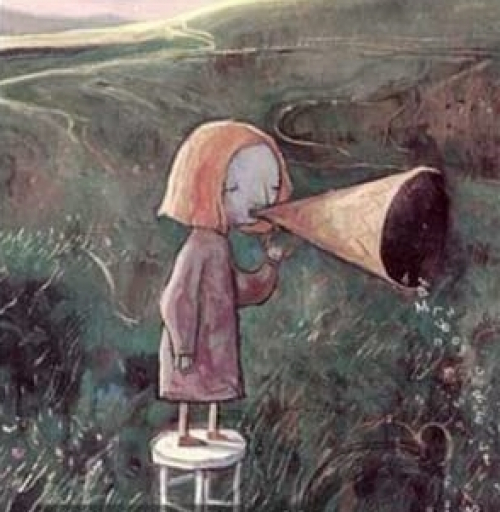Culture for All: Why Children's Literature Matters

As part of the Culture for All series we're proud to present a short film about children's literature by Kim Reynolds, followed by the text of her talk
Why Children’s Literature Matters
People often ask me why I study children’s literature. The question comes from the misconception that children’s books are merely a stepping stone to ‘real’ books. In fact, they provide the platform through which most children enter culture and learn to think about the world. What I find particularly exciting is the way that children’s literature, whether in the form of told stories, printed material or performances, contribute to the social, political and aesthetic transformation of culture.
One way they do this is by encouraging young readers to challenge received opinion and approaching ideas, issues, people, problems and places from new perspectives as when the child in Hans Christian Andersen’s ‘The Emperor’s New Clothes’ speaks truth to power. Such stories help children and young people to recognise the fallibility of those in power and that the way the world is organised is not inevitable, meaning it can be changed.
As well as offering new perspectives, children’s writers and illustrators frequently reimagine the world as it is, was and might be. Think, for instance, of how many folk and fairy tales show the weak and marginalised in society triumphing over the rich and powerful. In the interwar years children’s writers such as Geoffrey Trease championed workers over masters and told of injustices endured by ordinary people in many parts of the world.
Such stories have come to be known as ‘radical children’s literature’, a body of writing with a clear set of characteristics and ambitions. These are to
- encourage social change
- introduce new visions of society
- assume the young are socially aware, competent and interested in improving society
- give readers the skills, ideas, and information necessary to effect change
- aim for a stable, fair and equal society
- feature all kinds of children, and
- value youthful opinions.
The potential for resistance and transformation
In other words, radical children’s literature sees both children and children’s literature as important in themselves and as replete with transformational potential.
Radical writing has existed from the beginnings of children’s literature, contributing to cultural revolutions and campaigns of resistance. Some of the earliest children’s books looked to the rising generation to help eradicate forms of injustice such as slavery. Thomas Day’s bestselling novel, Sandford and Merton, published in instalments in the 1780s, rails against the corrupting influence of the slave trade on British life. In it, Tommy Merton, who began life in Jamaica as the pampered son of a British plantation owner, is introduced to a former slave now living in England. Learning how this man grew up, was captured, abused, and became free, makes Tommy question the very system that provides his wealth. By influencing young British readers, Day’s book helped to prepare the way for the Slavery Abolition Act in 1833.
Slavery and racism have not disappeared, of course, meaning radical children’s literature must continue to inform each generation of its pernicious effects in their own time.
A notable example is Journey to Jo’burg (1985), by the South African-born writer, Beverly Naidoo. This tale of two black children living under apartheid graphically illustrates of the realities of the brutal injustices of that regime. Banned in Naidoo’s native country, the book was published to acclaim in Britain.
Today, radical children’s literature informs readers of the many ways BAME people have and continue to contribute to British life and culture over time, from Catherine Johnson’s books about people of colour who have been erased from history to Dean Atta’s Black Flamingo (2019), an upbeat verse novel about a mixed race drag artist. It also highlights the prejudices and obstacles encountered by migrants and refugees who have come to the UK to find safety and a better way of life.
Addressing classism and celebrating working-class culture
As the example of slavery shows, from its inception, radical children’s literature has combatted discrimination of all kinds, at home and in other countries. In the 1960s and 1970s, there was a particular focus on the way the British class system blighted lives and divided families. An important strategy for addressing classism in children’s books was to celebrate working-class lives and culture, as in Alan Garner’s Stone Book Quartet (1976-8) and the Nippers reading scheme conceived by Leila Berg and launched in 1968. One Nippers author, Jacqueline Wilson, is one of the most popular children’s writers of recent years. She grew up on a council estate and regularly writes books that explore and validate the lives of children and families affected by economic deprivation.
Other issues regularly featured in radical writing today include prejudice based on biological sex, sexual orientation, religion and age. Some of the most effective ways of bringing about change come from works that appreciate and celebrate difference. That said, the ambit of radical writers and illustrators is wide. Other significant topics regularly addressed in radical children’s literature include pacifism, access to health, education and opportunities, living conditions, children’s rights, size, disability and caring for the planet.
Radical children’s books have been highlighting environmental issues and encouraging children to care for nature for decades. In the last century, when the impact of industrialisation, over-population and excessive consumption was beginning to be understood, books about animals and the environment became popular. Dr. Seuss’s The Lorax (1971) warned against environmental destruction, while Colin Dann’s bestselling series, The Animals of Farthing Wood (1979), showed humans’ impact on animals’ lives. These themes live on, for instance, in the award winning novels of Gill Lewis, vet and wildlife activist.
Radical writers have for long warned about the consequences of human action on the planet. The turn of the millennium saw a great many stories in which the future is shown as difficult and unfair because resources are scare on a depleted and damaged planet. Philip Reeve’s Hungry City Chronicles (2001-6) are set in the far-distant future after the world we know was blasted with weapons that have permanently blighted it.
Such devastating critiques of humans’ actions can lead to feelings of hopelessness, but radical children’s literature as a body of work strives to balance such warnings with the belief that situations can be improved. Some books focus on collective action and political solutions. For instance, Faith Ringgold’s Tar Beach (1991) combines informative history with magical realist adventures to tell the story of American labour unions and the underground railroad. Other books feature child characters helping to stop pollution, caring for endangered species, standing up to bullies, speaking out about abuse, and generally preparing themselves to help bring about a more socially just and sustainable world.
Given the many very real threats to the planet, peace, global economics and health, there is a great need for radical writing that will prepare, sustain and encourage young readers to become young activists.
As the links below show, there are a great many resources that provide lists and descriptions of books that promote progressive change. Some good places to start are:
Liverpool Learning Partnership Diversity
The Centre for Literacy in Primary Education
Booktrust provides lists on various topics including Black Lives Matter
The journal Books for Keeps runs a regular feature on BAME representation in children’s books
And here are some other useful links, on classism, diversity and activism

Kim Reynolds
Kimberley Reynolds is the Professor of Children’s Literature in the School of English Literature, Language and Linguistics at Newcastle University in the UK. Recent publications include Children’s Literature in the Oxford University series of Very Short Introductions (2012) and Left Out: The Forgotten Tradition of Radical Publishing for Children in Britain, 1910-1949 (Oxford University Press, 2016).
